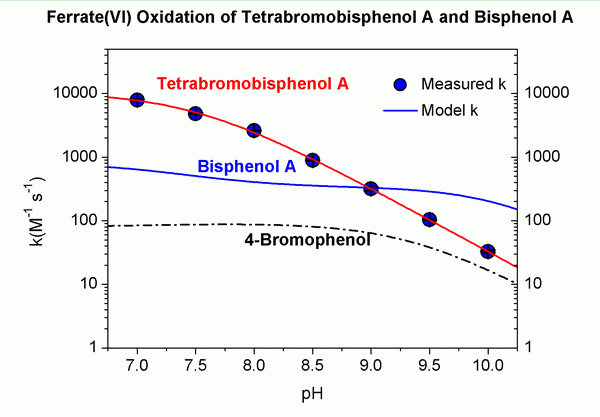广州地化所在绿色水处理剂高铁酸钾去除新兴有机污染物机制研究方面取得新进展
近年来,新兴有机污染物在污水处理厂出水和水环境中频繁检出,给水生态系统和人类健康带来潜在风险。传统的水处理工艺对新兴有机污染物的去除能力有限,亟需一种有效的深度处理方法。高铁酸钾(Fe(VI))是一种集氧化、吸附、絮凝为一体的环境友好型多功能水处理剂,然而关于Fe(VI)去除水中新兴有机污染物的机制方面却缺乏深入的研究。
中科院广州地化所应光国研究员和杨滨博士所在研究小组对Fe(VI)氧化降解水中微量溴代阻燃剂四溴双酚A(TBBPA)的反应机理、去除效率与安全性进行了深入研究,并与双酚A(BPA)的降解特性进行了对比。结果表明,Fe(VI)可以有效地去除水中TBBPA和BPA。研究采用形态反应动力学模型,计算得到Fe(VI)与非解离态和解离态TBBPA的反应速率常数。通过有机质谱等现代分析技术跟踪并鉴定了Fe(VI)与TBBPA的降解产物,发现Fe(VI)主要通过β-断裂等反应机制将TBBPA氧化降解成低溴化合物。更为重要的是,Fe(VI)的氧化降解作用可以去除TBBPA及其产物的内分泌干扰效应(雄激素效应、抗雌激素效应和抗雄激素效应)。此外,进一步实验还研究了水体颗粒物对Fe(VI)去除TBBPA和BPA过程的影响。研究结果为Fe(VI)去除水体中新兴有机污染物的应用提供科学依据,揭示Fe(VI)氧化技术是一种极具应用前景的新型水处理技术。
该研究成果已发表在Water Research上(Yang, Bin; Ying, Guang-Guo; Chen, Zhi-Feng; Zhao, Jian-Liang; Peng, Fu-Qiang; Chen, Xiao-Wen. Ferrate(VI) oxidation of tetrabromobisphenol A in comparison with bisphenol A. Water Research, 2014, 62: 211-219. DOI: 10.1016/j.watres.2014.05.056)。
论文英文摘要见下文:
Ferrate(VI) (Fe(VI)) oxidative removal of various organic micropollutants mainly depends on the reactivity of Fe(VI) to target micropollutants and coexisting constituents present in source water. This study evaluated the potential of Fe(VI) oxidation of the brominated flame retardant tetrabromobisphenol A (TBBPA) by using reaction kinetics, products identification and toxicity evaluation, and investigated the influencing effects of humic acid and clay particles on Fe(VI) removal of TBBPA in comparison with bisphenol A (BPA). The obtained apparent second-order rate constants (kapp) for Fe(VI) reaction with TBBPA ranged from 7.9(±0.3)×103 M?1 s?1 to 3.3(±0.1)×101 M?1 s?1 with the half-life (t1/2) ranging from 1.7 s to 419.3 s at pH 7.0-10 for an Fe(VI) concentration of 10 mg L-1. Easier oxidation by Fe(VI) was observed for TBBPA than for BPA. Fe(VI) can destroy and transform the TBBPA molecule through β-scission reaction, yielding the chemical species of low bromine-substituted products. More importantly, the oxidation of TBBPA by Fe(VI) led to the loss of its multiple hormonal activities (androgenic, antiestrogenic and antiandrogenic activities). The organic component humic acid decreased the TBBPA and BPA reactions with Fe(VI), while the inorganic component montmorillonite had no effect on their removal within the tested concentrations. Increasing the Fe(VI) dosage can reduce the effects of soluble organic matter and clay particles present in source waters on the degradation process, leading to the complete removal of target micropollutants.

有机地球化学国家重点实验室&广州地化所科技处 供稿

 新闻动态
新闻动态
